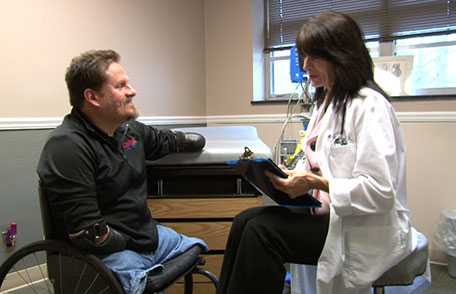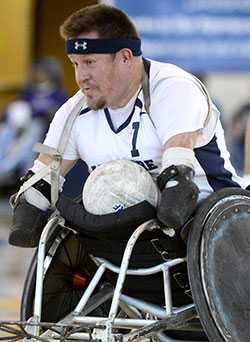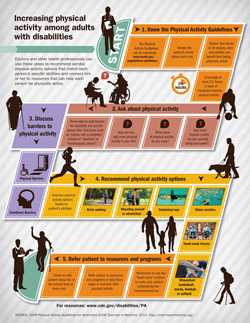Physical Activity is for Everybody

Everybody, including people with disabilities, needs physical activity for good health. However, nearly half of adults with disabilities who are able to be physically active don’t get any aerobic physical activity. Doctors and other health professionals can follow 5 easy steps to increase physical activity among adults with disabilities.
Physical activity plays an important role in maintaining health, well-being, and quality of life. According to the 2008 Physical Activity Guidelines for Americans, physical activity can help control weight, improve mental health, and lower the risk for early death, heart disease, type 2 diabetes, and some cancers. For people with disabilities, it can help improve the ability to do activities of daily living and be self-sufficient.
In the United States, about 1 in 5 people have a disability. A disability is any condition of the body or mind that makes it more difficult for the person with the condition to do certain activities and interact with the world around them. Disability does not equal poor health, and most adults with disabilities are able to participate in regular physical activity and avoid being inactive. However, nearly half of all adults with disabilities don’t get any aerobic physical activity. Aerobic physical activity is when the body’s large muscles move in a rhythmic manner for a sustained period of time, thus improving heart and lung fitness. Examples of aerobic activities that might be available to adults with disabilities include walking, water aerobics, swimming, hand-crank bicycling, and various wheelchair athletics.

Bob Lujano – Bronze-medal Paralympian in Quad Rugby
Healthcare providers are in a key position to influence physical activity participation among their adult patients with disabilities.

Increasing Physical Activity among Adults with Disabilities Infographic
View large version and text description.
Healthcare providers play a role
Healthcare providers are in a key position to influence physical activity participation among their adult patients with disabilities. First, adults with disabilities are more likely than those without disabilities to visit a healthcare provider on a regular basis. In addition, they are more likely to be physically active if their provider recommends it.
Here are five easy steps healthcare providers can follow to encourage people with disabilities to be physically active:
1. Remember that Physical Activity Guidelines Are for Everybody
- Doctors and other health professionals should recommend physical activity, based on the 2008 Physical Activity Guidelines [8.35 MB], to their patients with disabilities. Adults of all size, and abilities can benefit from being physically active, including those with disabilities.
- Adults should get at least 2-and-1/2 hours of aerobic physical activity each week at a moderate-intensity level.
- When adults with disabilities are not able to meet the above guidelines, they should engage in regular physical activity according to their abilities and should avoid being inactive.
2. Ask about Physical Activity
Doctors can ask the following questions regarding physical activity participation by their patients with disabilities:
- How much physical activity are you currently doing each week?
- How often?
- How long?
- At what intensity level?
- What types of physical activity do you enjoy, now or in the past?
- How can you add more physical activity to your life?
3. Discuss Barriers to Physical Activity
Adults with disabilities face barriers to getting aerobic physical activity. Discuss the following barriers with your patients with disabilities to help them find ways to be more active:
- Knowing about and getting to programs, places, and spaces where they can be physically active;
- Having social support for physical activity (such as, setting up a buddy system, making contracts with others to complete specified levels of physical activity, or setting up walking groups or other groups to provide friendship and support);
- Having limited information about accessible facilities and programs; and
- Finding fitness and health professionals who can provide physical activity options that match their specific abilities.
4. Recommend Physical Activity Options
Recommend physical activity to your patients with disabilities, You can share the following guidance from the 2008 Physical Activity Guidelines: [8.35 MB]
- Engage in the amount and types of physical activity that are right for them;
- Find opportunities to increase regular physical activity in ways that meet their needs and abilities;
- Start slowly, based on their abilities and fitness level (for example, be active for at least 10 minutes at a time, and slowly increase activity over several weeks, if necessary);
- Include aerobic physical activities that make them breathe harder and their heart beat faster for important health benefits, such as reducing the risk of heart disease, stroke, diabetes, and some cancers;
- Know that most aerobic physical activity may need to be modified, adapted, or may need additional assistance or equipment; and
- Avoid being physically inactive. Some physical activity is better than none.
5. Refer Patients to Resources and Programs
Visit CDC’s Disability and Health website to find resources and programs, and become familiar with a wide range of physical activity options that you can recommend to your adult patients with disabilities.
Do you want to know the proportion of healthcare providers who currently recommend physical activity to their patients with disabilities? Visit the Disability and Health website to see key findings from the article “Primary care providers’ level of preparedness for recommending physical activity to adults with disabilities.”
What CDC and Our National Partners Are Doing
CDC’s Division of Human Development and Disability (DHDD) in the National Center on Birth Defects and Developmental Disabilities supports and provides funding for two National Centers on Disability that focus on improving the quality of life for people living with disabilities, including their physical activity:
- National Center on Health, Physical Activity, and Disability and
- Special Olympics Healthy Athletes Program.
DHDD also supports 19 state-based programs to
- Promote equal access to opportunities for optimal health;
- Prevent long-standing diseases, like diabetes, heart disease, asthma, and arthritis; and
- Increase the quality of life of people with disabilities.
Learn more about the State Disability and Health Programs.
- Page last reviewed: October 18, 2017
- Page last updated: October 18, 2017
- Content source:
- National Center on Birth Defects and Developmental Disabilities
- Page maintained by: Office of the Associate Director for Communication, Digital Media Branch, Division of Public Affairs




 ShareCompartir
ShareCompartir